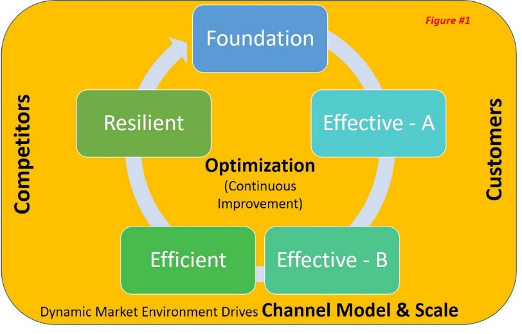Channel strategy for a market is defined, considering several factors – namely target customers, competitors, ease of doing business, and others. Once the channel model (i.e., Distributor / National Dealer/ Dealer/ Others) is defined, the channel partner’s scale is driven by the scale of the targeted customer segment besides others.
In the above macro context, channel partner identification followed by development takes place. Channel partner development stages are captured in the figure above (in general applies across sectors but is stated here specifically from industrial/machinery business standpoint).
A brief explanation of each of the stages as below:
Foundation stage focuses on developing the channel partner fundamentals, e.g., coverage (locations), manpower strength, manpower capability, working capital, others.
Effective – A stage focuses on delivering on at least competitive but ideally ‘best in class’ customer satisfaction to the customer base (which is typically small at this stage – hence relatively more manageable to be provided a higher level of customer experience)
Effective – B stage focuses on delivering on gaining market share followed by service parts sales growth at the back of existing & growing machine population.
Efficient stage focuses on ensuring dealer financials are meeting healthy thresholds (which is defined by channel model & market) in terms of profitability, turns, and return on operating assets. Dealer business plan developed at the inception stage should capture the upfront investment & future returns expectations for alignment between channel partner & OEM concerned.
Resilient stage focuses on driving sustainability through higher fixed cost absorption of dealership through service & parts sales contribution. Higher the absorption lower the dependence on machine sales in any year to keep the business afloat.
Though in the model, you can see a discrete progression from one stage to another in terms of channel partner development – but typically, the stages overlap. And over time, you do see stages get repeated as the performance targets, market dynamics, and others change – termed here as Optimisation (Kaizen approach to channel development).

